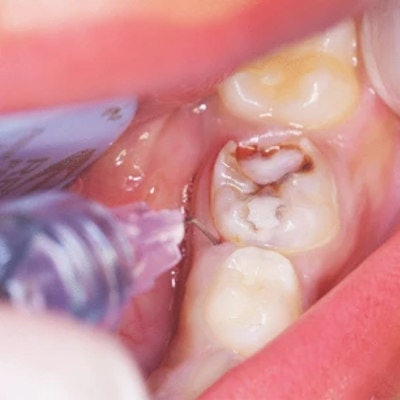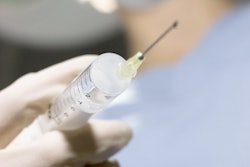
Children injected with computer-controlled intraligamentary anesthesia prior to molar extractions felt less pain than those given typical inferior alveolar nerve blocks, according to a study published May 20 in BMC Oral Health.
Not only was the rapid-onset, short-duration intraligamentary technique as effective as the conventional method, but there were also no reports of children biting their lips and cheeks following the procedures, the authors noted. About one-third of children who received the conventional method reported biting their lips and cheeks, according to the study.
"CC-ILA (computer-controlled intraligamentary anesthesia) provides significantly less painful injections than conventional techniques and has proved to be as effective as IANB (inferior alveolar nerve block) during extraction of mandibular primary molars," wrote the authors, led by Dr. Rodaina Helmy of the department of pediatric dentistry and dental public health at Alexandria University in Egypt.
Because administering local anesthesia to children is challenging, pediatric dentists are continually searching for less painful methods. Though IANB is the most commonly selected technique for anesthetizing mandibular primary and permanent molars, its use can result in minor problems, like self-inflicted bites to the lip and major complications, including needle breakage and trismus.
To overcome these limits, other techniques, such intraligamentary anesthesia, have been promoted. This is an intraosseous injection, with local anesthesia reaching the cancellous space in the bone via the periodontal ligament. It's effective immediately and prevents soft-tissue injury, but it only lasts for about 20 minutes, according to the study.
 Administration of computer-controlled intraligamentary anesthesia in a child's multirooted tooth. On the left, first insertion on the distolingual line angle of the tooth. On the right, second insertion on the mesiolingual line angle of the tooth. Image courtesy of Helmy et al. Licensed by CC BY 4.0.
Administration of computer-controlled intraligamentary anesthesia in a child's multirooted tooth. On the left, first insertion on the distolingual line angle of the tooth. On the right, second insertion on the mesiolingual line angle of the tooth. Image courtesy of Helmy et al. Licensed by CC BY 4.0.To assess children's pain experience, 50 healthy children between the ages of 5 and 7 who needed primary molar extractions were enrolled in a clinical trial. In January 2021, this trial was registered with ClinicalTrials.gov, a site maintained by the U.S. National Institutes of Health's U.S. National Library of Medicine.
Half of the children were given CC-ILA, and the other 25 were given IANBs. During injection and extraction, pain was measured using heart rate and the faces pain scale, which requires the children to select pictures that represented their experiences of indifference, satisfaction, and dissatisfaction.
Researchers also used the sound eye motor scale (SEM) based on recorded video. The SEM scale assesses an individual's pain based on crying, complaints, eye dilation, muscular contraction, and sudden hand and eye movements.
During injection, heart rate scores were lower in children in the intraligamentary anesthesia group. The median heart rate was 104.64 in the CC-ILA patients and 113.48 in the IANB group, they wrote.
In the children administered CC-ILA, 22 participants reported being satisfied after injection, and 21 reported being satisfied after extraction. In the IANB group, only 14 were satisfied after injection, and 13 were satisfied after extraction, according to the results.
In the CC-ILA group, the mean SEM score was 1.15 during injection and 1.76 during extraction. These scores were significantly lower than the other group at 2.53 and 2.53, respectively, the authors wrote.
Further, 24 hours after extraction, parents were contacted to keep track of instances of lip or cheek biting. In the alveolar nerve block group, 32% of the parents reported that their children experienced lip biting, while no children in the other group experienced this.
The study was not able to account for anxiety that may have affected the results and negatively affected patients' pain reaction scores, the authors wrote. Also, more studies should be conducted to investigate the effectiveness of CC-ILA for longer procedures before including it in routine dental care for children in the future.
"CC-ILA provides less painful injections when compared to the conventional IANB and is more generally accepted by pediatric patients," Helmy and colleagues concluded.



















